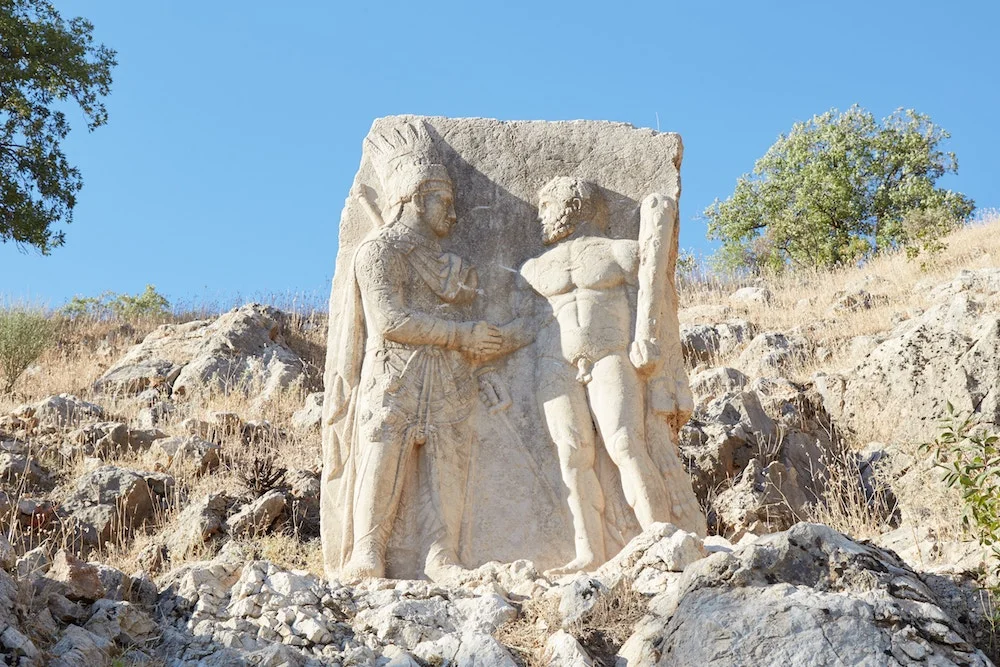Introduction
Hidden in the Arsemia Ruins of Adıyaman lies an extraordinary masterpiece that could rival the world’s most celebrated ancient relics: the Handshake Stele. This stunning relief, largely unknown outside archaeological circles, depicts a meeting between Antiochus I Theos, King of Commagene, and Heracles, the legendary Greek demigod.

While such a discovery would likely be a global sensation if found in Europe, this remarkable artifact remains underappreciated. Its historical, cultural, and artistic significance, however, makes it a testament to the rich heritage of Commagene, a kingdom that flourished at the crossroads of Greek and Persian civilizations.
The Handshake Stele: A Symbol of Unity
A Meeting of Power and Divinity
The Handshake Stele, dating back to the 1st century BCE, vividly portrays Antiochus I in a handshake with Heracles. Antiochus, known for his ambitious efforts to merge Greek and Persian traditions, is presented as an equal to the divine hero. This symbolic gesture reflects the king’s aspirations to divine favor and legitimacy as a ruler whose authority was both mortal and celestial.

The depiction of Heracles emphasizes strength and vitality through meticulous detailing of his muscular physique. Meanwhile, Antiochus’ confident stance conveys authority and grandeur, reinforcing the stele’s narrative of harmony between human and divine forces.
Masterful Craftsmanship
The artistic brilliance of the stele is evident in its intricate details. Heracles’ anatomy is rendered with precision, showcasing the sculptors’ deep understanding of human form. Antiochus, on the other hand, is depicted with a commanding dignity, his posture and expression exuding confidence. Together, they create a composition that is as much a political statement as it is an artistic triumph.
Arsemia: A Treasure Trove of History
The Summer Capital of Commagene
The Arsemia Ruins, once the summer capital of the Kingdom of Commagene, offer a glimpse into the grandeur of this ancient civilization. Beyond the Handshake Stele, the site is home to fascinating inscriptions that document the kingdom’s history, including the largest Greek inscription in Anatolia. These texts provide insights into Antiochus’ vision of cultural and spiritual unity.

Architectural and Archaeological Wonders
Arsemia also features an extensive network of rock-cut tunnels and ceremonial monuments, further underscoring its importance as a cultural and administrative hub. Together with the stele, these elements paint a vivid picture of a kingdom that thrived at the intersection of diverse traditions and ideas.
A Timeless Legacy
Cultural Syncretism at Its Best
The Handshake Stele is more than just an artifact; it is a profound representation of Antiochus’ syncretic vision. By blending Greek, Persian, and local Anatolian influences, the king created a legacy that was uniquely Commagenian. This harmonious fusion of cultures is a reminder of the power of diversity in shaping enduring civilizations.

Deserving Global Recognition
Despite its historical and artistic significance, the Handshake Stele remains relatively unknown outside Turkey. Its discovery and preservation should serve as a call to action for greater awareness and appreciation of the rich cultural heritage of Commagene.
Conclusion
The Handshake Stele of Antiochus and Heracles stands as a testament to the ambition, artistry, and cultural sophistication of the Kingdom of Commagene. Nestled in the Arsemia Ruins, it tells a story of unity between the mortal and the divine, embodying a vision of harmony that transcends time.
For those who seek inspiration in the legacies of ancient civilizations, this stele—and the treasures of Arsemia—offers an unparalleled glimpse into the ingenuity and aspirations of a forgotten kingdom.
